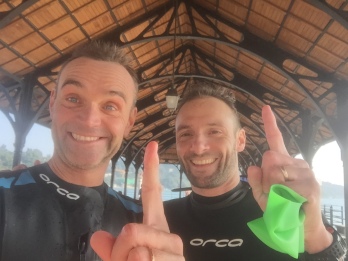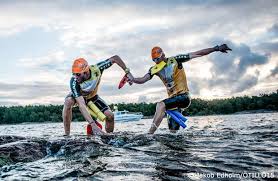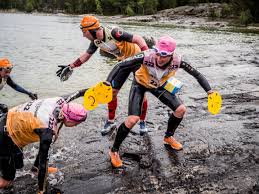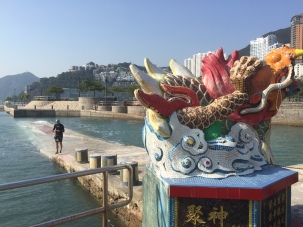
-Swimrun, huh? Yeah, I know what it is, it’s also known as Aquathlon, right?
-Wrong!
Swimrun is not Aquathlon, it is much more than just swimming and running. It’s “a multistage competition where participants are running and swimming over a cross-country race-course that involves many transitions between the swim and run stages of the race (…) The goal is to go from a starting point to a finish point through a course with several checkpoints” (Wikipedia). It’s in fact closer to adventure racing, I would say.
There are no rules as to how long the runs and the swims should be, nor how many transitions there should be. There are some standard rules though:
- All the equipment that a participant starts with has to be carried until the end. That means that you have to swim with your shoes and run with your swim equipment, i.e. your wetsuit, swim cap, goggles, etc,
- The use of floating equipment is allowed and encouraged: most competitors use (oversize) paddles and (oversize) pullbuoy,
- Swimruns are usually carried in teams and teammates are often tied to each other with a rope, not to lose one another during the rough swim sections.
 Don’t tell me this is an Aquathlon, please
Don’t tell me this is an Aquathlon, please
Swimrun started just like Ironman did, around a table, with semi-drunk fellows challenging each other. Their idea was to get themselves from Sandhamn to Utö in the Stockholm archipelago. It became a reality in 2002 but it only became a race, called Ö till ö, or island to island, in 2006. Just like Ironman, you now need to qualify at one of the very few qualifying races to get to what has become the Ötillö World Championship. And just like Ironman, it is very competitive, especially given that the competitors get more and more specialized (NB: there is also a lottery and a qualification on merit).
I started triathlons in 2000 and felt a bit like a trailblazer, as there were relatively few competitors at the time. I was introduced to bricks and crazy long workouts by a couple of older athletes who were in their late 30s -and whom I considered like old wisemen at the time (little did I know that I would continue into the sport being waaaay older than they were…). It was a nice refreshing experience after a few years of road running, doing loads of 5k, 10k, 21k on concrete roads in industrial places and city centers. I instantly became ‘a triathlete’. Then in 2006, after a lot of traveling and moving, I ended in a place where training became boring and complicated (Paris…) and turned to trail running. Once again I felt like I was part of a crazy tribe, as there was no standardized equipment and we were all inventing tricks, stealing ideas from other sports to be lighter and faster.
The swimrun advent is the same, but –to me- better, more exciting. It reconciles what I love most, swimming in rough open water with big paddles -a real strongman swim compared to the often sheltered Ironman swims- and trailrunning, a discipline I was good at 10 years ago (2006 27h50 UTMB finisher –on a 10k shorter course than now). It has a flavour of novelty, of unknown challenge. Just like with trailrunning, what nature throws at us dwarfs us, and the landscape is usually breathtaking.
 Hell in paradisiacal places, the perfect combination
Hell in paradisiacal places, the perfect combination
Finally, it brings to the table what I have rarely experimented, team bonding. Since I swam around Lantau Island in Nov 2014 with my mate Bruce Pye, I have been longing to find again that feeling of sharing loads of pain and adventure with a buddy.
 Team spirit for good!
Team spirit for good!
As far as I can see, as of late 2015-early 2016, swimrun does not exist in Asia. There are quite a few countries where it could develop and thrive though, like Hong Kong of course, but also Japan, Taiwan, China, and if you look a bit more into it, I suspect Laos and Vietnam could be good candidates too (with some reserves on the water quality…).
Olivier Courret and myself were vaguely starting to think about organizing a swimrun event in HKG, just for fun, until a synchronicity of several events accelerated the whole process:
- Two of the athletes I coach contacted me to announce that they had signed up for a new Ötillö race, Ötillö UK, in June 2016,
- I contacted my swim around Lantau buddy Bruce, asking if he would fancy signing up to that same race as my teammate, and he accepted instantly,
- Good friend and top trail runner Clement Dumont sent me a French documentary on Ötillö Sweden which blew my mind away,
- The swimrun modeling session with Orca I had that week (I’m the model for Orca’s size M clothing and Orca is developing a range of items for swimrun races) lingered on and Olivier Courret and myself decided at the end of it that we would do a swimrun event the following week.
At this stage, we wanted to keep it very low key as we really did not know how our day would unfold. So it was just the two of us, the two Olivier, the two swim Frenchies.
So here we were on a bright joyful Wednesday morning on Stanley beach, on December 16, 2015, ready for our historic experiment. We were hoping to document this adventure with pictures, step by step, unfortunately Olivier Courret’s camera didn’t survive the experience and we ended up with only a handful of not so significant pictures taken with my phone.
The total of the course was approximately 27k, with over 6k of swimming -including two rough sections of over 1.5k around the beginning and in the end- and 21k of mainly trail, a bit more than was anticipated by Olivier Courret, who sent me the following:
S: Stanley Pier – St Stephen Beach (about 500m)
R: St Stephen Beach – Stanley Main beach (about 1km)
S: Stanley Main Beach – Turtle Cove (about 1.5km)
R: Turtle cove- Tai Tam Harbour (about 1.5km)
S : Tai Tam Harbour crossing (500m)
R: Tai Tam Harbour – Repulsebay green pagoda (6km)
S: Repulse bay Pagoda to deepwater bay (1.3km)
R: Deep water bay to Repulsebay Pier (2.3km)
S : Repulsebay pier – Middle bay (about 500m)
R : Middle bay – South bay Beach (about 1.5km)
S: South bay beach – Chum Hum Kok (about 1700m)
R : Chum Hum kok – Stanley Pier (about 1.5km)
Total : 17-21km
S: 5 / 7 km
R : 12 / 14
 Some swimrun racers write down the distance on their paddles, Olivier C decided to get tattooed for life to remember this historic day
Some swimrun racers write down the distance on their paddles, Olivier C decided to get tattooed for life to remember this historic day
It was a relatively windy day and most swims were challenging. On top of the list of gear above mentioned, I also had a silly waistbelt full of junk that wasn’t tight enough and was causing extra drag. That didn’t help. But none of the distances were long and the temperature was just perfect. I particularly appreciated the Taitam harbour crossing, very different in terms of conditions and scenery. I could tell Olivier Courret was concerned about the last swim that he knew would be rough but he’s a tough guy and all in all, every swim went very smoothly.
The runs were mostly easy… because we decided they would be easy. None of us knowing how hard this new sport would be, we took all the runs at what we would call ‘endurance pace’, i.e. we were cracking jokes and making plans about the future of swimrun in HKG and Asia in general non-stop while running. The longest trail run was over 10k, nothing too hard.
I confirm that the least junk you carry, the better. Paddles hanging loose can drive anybody mad after 20k. The big question mark is how to make sure you don’t get dehydrated in training if you don’t carry water, as I suffered during the longest bit. In races, you have aid stations, but in training, we only had one stop at a 7/11 and another one at a vending machine over a 4h30 day, which was, for me, a bit short in terms of fluid replenishment. Some racers use Camelback or similar, I can’t picture doing it in races, but it might be a good idea in training. Still, swimming with a Camelback…yuk !
One of the biggest takeouts of this day –which was confirmed by everything I heard and read after this- is that you can waste tons of time in transitions. The key is to keep moving: anticipate the transition coming up, start preparing for the next sport, and roll into it without ever stopping. Swimrun has an enormous component of fitness, but the skill of seamless transitioning needs to be trained with as much dedication as swimming in rough water, walking of wet rocks and running on trails. We spent one hour transitioning (including a bit of food and pictures taking…but still) over a 4h30 training day!
 How to waste 1h in transitions: by staying static: stop, put on your cap, put on your goggles, put on your pullbuoy, put on your paddles, adjust your goggles again…
How to waste 1h in transitions: by staying static: stop, put on your cap, put on your goggles, put on your pullbuoy, put on your paddles, adjust your goggles again…
Our recce was the perfect occasion to test different options of gear, and we can already draw conclusions from our countless mistakes:
- Triathlon-type of racebelt, to tie the rope around our waist: verdict: not good! too elastic, I spent a lot of time tying it up back because it got too loose too often. Will need to find a non elastic belt,
- Pullbuoy, tied to my race belt when running: not a bad option, but there’s a better one. I put the pullbuoy between my back and the race belt while running and the pullbuoy stayed in place. Olivier Courret tied his pullbuoy on one of his legs. When he ran, the pullbuoy was firmly held on the size of his leg, a very standard way to do things in swimrun, and the one I will adopt next time,
- Paddles: I ran with them by flipping them upside down, then I decided to remove them and held them in one hand -none of these options were good. Again Olivier Courret won by tying his paddles to a carabiner. Carabiners are great for swimrun and it’s a good thing to have one or two in reserve,
 Olivier Courret’s set-up: pullbuoy on the side, paddles attached to belt with carabiner
Olivier Courret’s set-up: pullbuoy on the side, paddles attached to belt with carabiner
- Rope: Olivier Courret brought a decent one. The benefits of the rope that we discovered were: when swimming in first position, I could feel with the tightness of the rope where Olivier C was without having to sight him, I could also tell when the rope was getting tense often, meaning when my teammate was struggling a bit. The drawback was: drafting with a rope is not easy, as it goes in the way. On the swimrun videos I saw, it seems that drafting is a rare occurrence anyway, probably because the water is too rough to allow it,
- Shoes: yes, we swim with shoes, and that’s why we swim with pullbuoy, to compensate for the drag. I ran without socks, as a triathlon dork, but socks are probably recommended, at least the type of socks that do not retain too much water. I chose a pair of North Face shoes that didn’t seem to become like sponges in water, but there are probably better shoes in the market. There doesn’t seem to exist specific swimrun shoes yet, but it won’t be long before brands launch specific models.
- Wetsuit: Olivier lent me an Orca swimrun prototype for that day. Swimrun wetsuits are different from triathlon wetsuits:
- They have a zipper at the front, for ventilation while running,
- They are often cut above the knees, and designed to be cut above the elbows,
- They are very flexible around the legs,
- The butt areas is covered with anti-abrasive material, in case of falls or slides on rocks,
- The number of millimeters is not limited so anything goes… but what helps for swimming may create problems for running,
- There are pockets inside the suit, to accommodate for the race GPS (heavier and more bulky than the ones used in triathlons), to carry gels, mandatory material (compass, survival kit, maps,), etc.
- There are many innovations coming up to accommodate for this new type of races.
***
All in all, we really loved the experience. No surprise here. The next step will be to do the same course, or similar, with a group of triathletes, swimmers and runners, with the limitation that they all need to be strong open water swimmers. It’s in the pipe.
In parallel, four of us in HKG are ramping up the training for Ötillö UK, with me coaching my 3 buddies, so I’ll have plenty of things to share in the coming months. Stay tuned…
What we did:
A couple of swimrun links:
 Bravo les Olivier !
Bravo les Olivier !
Great post Olivier! Sounds very tough but very inspiring! I’m sure you guys will make history!
LikeLike
Bonjour,
Je suis M.Kévin Ransbotyn. J’ai lu votre poste et je vous félicite pour l’initiative que vous avez lancé à Hong Kong. ça m’a donné envie. Vous avez l’air d’avoir vécu une belle première expérience. Le coup des plaquettes qui pourraient rendre n’importe qui fou, je veux bien vous croire.
Je ne savais pas du tout jusqu’à hier que ce type de course existait même si comme beaucoup de monde ça m’est arrivé de le faire par moi même.
Je vis sur Qingdao mais me déplace relativement souvent sur Hong Kong. Je serai ravi d’avoir une discussion avec vous lors de mon prochaine passage.
Au plaisir de vous lire.
Kévin Ransbotyn
LikeLike
Hi Kevin, sorry for my late reply. Please tell me when you’re in HKG and we’ll meet. Thanks.
LikeLike